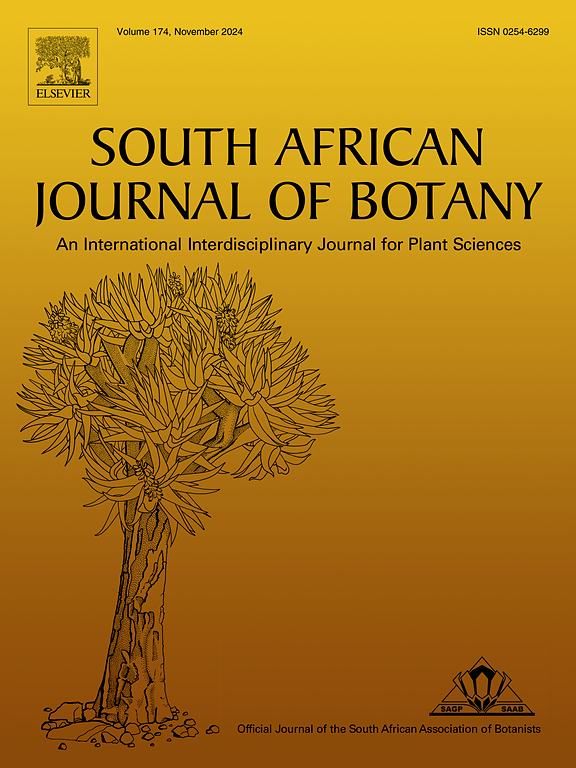Shrub invasion drives herbaceous vegetation degradation in semi-arid rangelands of the Eastern Cape Province of South Africa
IF 2.7
3区 生物学
Q2 PLANT SCIENCES
引用次数: 0
Abstract
Shrub invasion is a global concern for biodiversity conservation, and rangeland productivity. Since early 1900s, a dwarf shrub from the Asteraceae family, Pteronia incana has invaded vast areas of the Grassland and Thicket biomes of South Africa. However, it is unclear how this shrub affects herbaceous vegetation and whether its effects are modulated by topography in the Eastern Cape Province, South Africa. Three 1-hectare blocks were delineated in the mountain top, middle and bottom slopes in Lower Mgwalana and Qeto communal rangelands from which three 10 × 10 m plots were assigned to characterize three replicates of open, moderate and high invasion levels of <10 %, >20–40 % and >40 % shrub cover, respectively. We determined shrub cover and density in each plot and assessed herbaceous vegetation in three 1-m2 quadrats per plot. In total, 22 grass species were recorded, with their total abundance declining with shrub invasion while the opposite was true for forbs. However, two palatable grass species (Digitaria eriantha and Eustachys paspaloides) remained dominant in invaded sites. Graminoid cover varied significantly with shrub invasion irrespective of slope position. Highly invaded sites (HIS) generally exhibited lower graminoid cover relative to moderately invaded (MIS) and open areas (OAs). Conversely, cryptogam and litter cover were higher in HIS relative to OAs. Plant density varied by invasion levels only in the bottom slope, whereas species diversity showed differences in the middle and top slopes, with both vegetation attributes being highest in OAs compared to MIS and HIS. Overall, shrub invasion facilitated herbaceous vegetation degradation, calling for active restoration interventions including strategic removal of shrubs in strips for herbaceous recovery and leaving some shrubs as contour buffer strips to minimize soil erosion. Brush-packing can be incorporated into shrub-cleared strips to improve infiltration and minimize impact of direct rain splash.
灌木入侵驱动南非东开普省半干旱牧场草本植被退化
灌木入侵是全球关注的生物多样性保护和草地生产力问题。自20世纪初以来,一种来自菊科的矮灌木,印加翼龙(Pteronia incana)已经入侵了南非的大片草原和灌丛生物群落。然而,目前尚不清楚这种灌木如何影响草本植被,以及它的影响是否受到南非东开普省地形的调节。在下Mgwalana和Qeto公共牧场的山顶、中部和底部划分了3个1公顷的地块,其中3个地块为10 × 10 m,分别表征了开放、中等和高入侵水平的3个重复,灌木覆盖率分别为10%、20% - 40%和40%。我们确定了每个样地的灌木覆盖和密度,并在每个样地的3个1-m2样方中评估了草本植被。共记录到22种禾本科植物,其总丰度随灌木入侵而下降,而草本植物则相反。然而,在入侵地,两种适口草(Digitaria eriantha和Eustachys paspaloides)仍然占据优势。禾草类盖度随灌木入侵而显著变化,与坡位无关。相对于中度入侵区和开放区,高入侵区禾本科植物覆盖度普遍较低。相反,相对于OAs, HIS中的cryptogam和凋落物覆盖度更高。植物密度仅在坡底存在差异,物种多样性在坡顶和坡中存在差异,植被属性在oa区均高于MIS和HIS。总体而言,灌木入侵促进了草本植被的退化,需要采取积极的恢复干预措施,包括战略性地清除带状灌木以恢复草本植被,并留下一些灌木作为等高缓冲带以减少土壤侵蚀。刷填料可以结合到灌木清理带,以提高渗透和减少直接雨溅的影响。
本文章由计算机程序翻译,如有差异,请以英文原文为准。
求助全文
约1分钟内获得全文
求助全文
来源期刊

South African Journal of Botany
生物-植物科学
CiteScore
5.20
自引率
9.70%
发文量
709
审稿时长
61 days
期刊介绍:
The South African Journal of Botany publishes original papers that deal with the classification, biodiversity, morphology, physiology, molecular biology, ecology, biotechnology, ethnobotany and other botanically related aspects of species that are of importance to southern Africa. Manuscripts dealing with significant new findings on other species of the world and general botanical principles will also be considered and are encouraged.
 求助内容:
求助内容: 应助结果提醒方式:
应助结果提醒方式:


